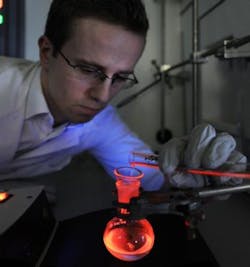Europium complexes emit red light at record efficiency
Two new luminescent compounds with europium complexes developed at the Institute of Physical Chemistry of the Polish Academy of Sciences (Warsaw, Poland) have potential for boosting the efficiency of organic light-emitting diodes (OLEDs). Both compounds have record-high luminescence efficiencies for their class at red wavelengths, and have properties conducive to fast, low-cost manufacturing of OLED films.
The compounds were prepared using phosphine oxides as co-ligands in europium ion-based complexes. A research group from the University of St. Andrews (Fife, Scotland) collaborating with the IPC PAS used the developed compounds to build prototype OLEDs generating nearly monochromatic red light.
“Both compounds, carefully designed by us, display in their class a record-breaking luminescence efficiency. As a matter of fact, we know red emitters with somewhat higher efficiency, containing iridium, but it's completely different type of materials,” notes Marek Pietraszkiewicz from the Institute of Physical Chemistry of the Polish Academy of Sciences (IPC PAS).
Red light emitted by europium complexes with phosphine oxides has a well-defined wavelength of about 612 nm. The luminescence quantum yields of these compounds reach 90%.
“We attach extended, highly rigid phosphine oxides to europium complexes,” says Michał Maciejczyk, a doctoral student from the International Doctoral Studies at the IPC PAS. "As a result, the energy delivered to the molecule is not dissipated in unnecessary vibrations or rotations."
One important advantage of these luminescent materials is their stability—they do not degrade when exposed to oxygen or light. Equally important is, however, the possibility to produce films of these materials via low-cost room-temperature solution processing.
Flexible photoactive anticancer dermal patches
Besides OLED lighting and displays, potential applications of the new materials include as flexible elastic dermal patches for use in anticancer therapies. The europium complex-based compounds incorporated in such patches would generate light of exactly known wavelength that could locally activate appropriately selected active ingredients, delivered earlier with other methods to patient's ill skin cells. During therapy, the dermal patch would require only a small power supply from a battery. Patient mobility would be minimally affected, and hospitalisation would not be needed any longer.
About the Author
John Wallace
Senior Technical Editor (1998-2022)
John Wallace was with Laser Focus World for nearly 25 years, retiring in late June 2022. He obtained a bachelor's degree in mechanical engineering and physics at Rutgers University and a master's in optical engineering at the University of Rochester. Before becoming an editor, John worked as an engineer at RCA, Exxon, Eastman Kodak, and GCA Corporation.

